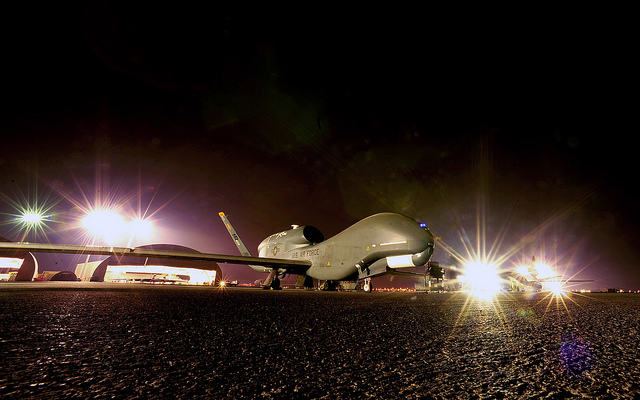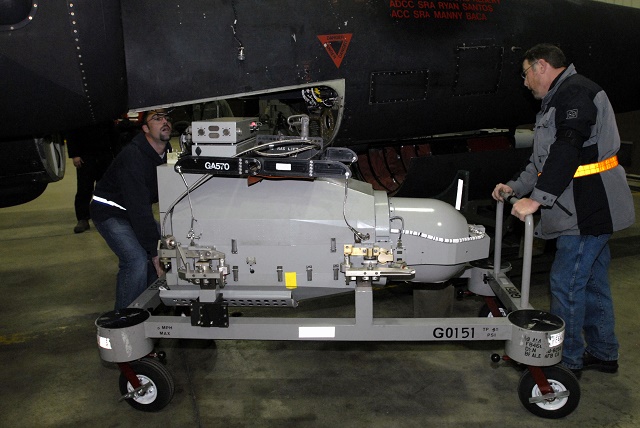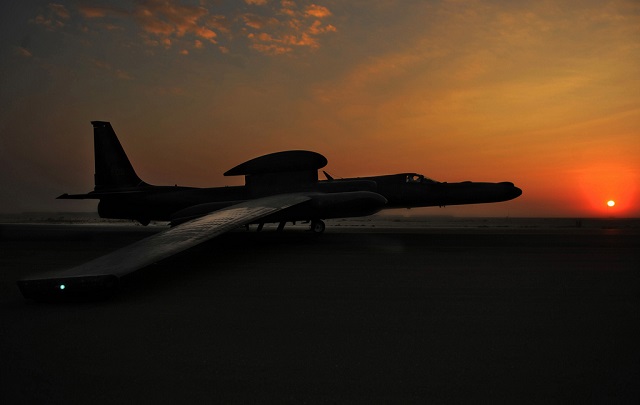Northrop Grumman’s RQ-4B Global Hawk would evolve into a “reconfigurable sensor-transporter” capable of carrying a variety of sensors weighing up to 544kg (1200lb) under a modification programme currently being assessed by the US Air Force.
The service has concluded that by making various hardware and software changes and adding 17 payload-attachment fittings to the fuselage floor, the Global Hawk could carry America’s most important surveillance and reconnaissance sensors, including those currently flown on the Lockheed Martin U-2 Dragon Lady.
“It is feasible to adapt the U-2’s Senior Year Electro-Optical Reconnaissance System-2B/C (SYERS-2B/C) and the Optical Bar Camera (OBC) onto the RQ-4B,” the air force says in a recent report to Congress, obtained by Flightglobal. “The study also shows that it is feasible to adapt the more modern alternative to SYERS, the MS-177, onto the RQ-4B.”

US Air Force
The United Technology Corp sensors are at the centre of a long-running debate over whether to retire the Lockheed U-2 or Northrop Global Hawk to cut costs, or keep both. Northrop has long said that with some modifications and the installation of a “universal payload adaptor”, the unmanned aircraft can carry and operate the sensors just as effectively as the manned alternative.
The SYERS-2 (a long-range, hyperspectral imaging sensor) and OBC have long been carried on the U-2 – which Lockheed contends is a superior spy platform because of its greater operating height, power, and payload capacity. However, Global Hawk’s ability to fly non-stop for 30h, compared to 9-12h for the U-2, means that its sensors can stay on target longer.
And despite reports to the contrary, the air force says there should be “negligible differences” in the performance of the sensors aboard the Global Hawk compared to the U-2, and likewise for the MS-177 that can be carried on the Northrop E-8C Joint Surveillance Target Attack Radar System (JSTARS).

An Optical Bar Camera is fitted to an Air Force U-2 Dragon Lady.
US Air Force
“National image interpretability rating scale (NIIRS) ratings are expected to be comparable to the U-2 within the operationally relevant range,” the report says, while also noting that the Raytheon-build imaging sensor system already on the RQ-4B could be upgraded to “match or exceed SYERS-2B capabilities”.
According to the report, pairing of the sensors with the Global Hawk requires upgrades to the aircraft’s current payload power tray assembly, air sensor management unit interface, airborne file server, and the associated equipment racks. Each new sensor also requires a customised “interface module” to provide the right pressurization, temperature, power, and data connections.
“There are integration and architectural changes required to facilitate the RQ-4B’s operation of either the SYERS-2B/C or MS-177 into the tasking, collection, processing, exploitation and dissemination architecture,” the report says. These changes would not inhibit simultaneous use of the Global Hawk Block 30’s signals intelligence system.
“Hardware and software upgrades are also necessary to pass command-and-control signals and sensor data to and from the ground.”
In 2013, the service estimated it would cost $487 million and take five years to modify its Block 30 Global Hawk fleet to carry OBC and SYERS, but those estimates have since been revised down. Northrop has offered to modify six airframes for $48 million. A second report containing the latest cost and schedule estimates is due out soon.
The air force has not decided whether it will pursue the modification, but Northrop has asked for government-furnished sensors to demonstrate its payload adaptor design.
The report notes that all eight SYERS-2 sensors are in operational deployment or are being upgraded to the latest 2C configuration. Of the nine in-service OBCs, six are fielded but three are “readily available to support a demonstration”. The service says a UTC-owned MS-177 sensor could potentially be made available.

US Air Force
Source: FlightGlobal.com



















